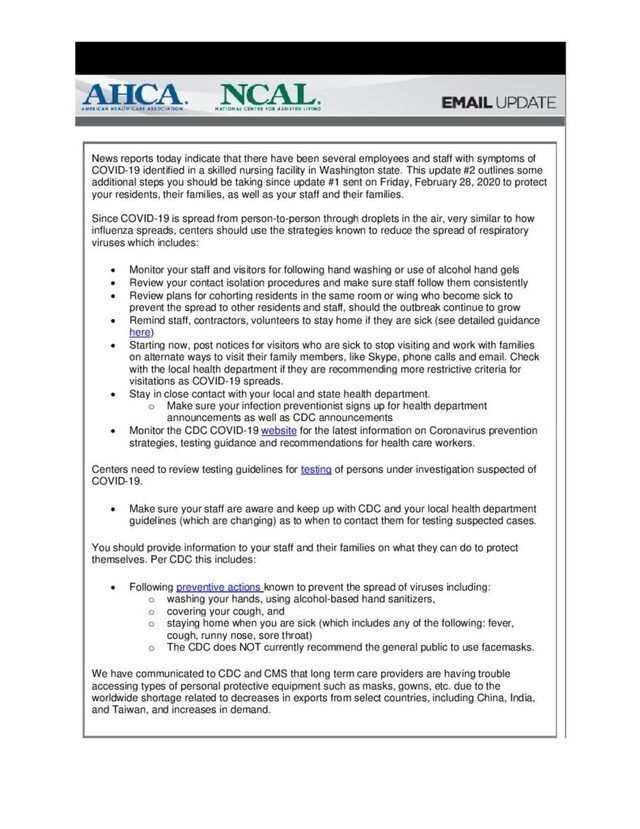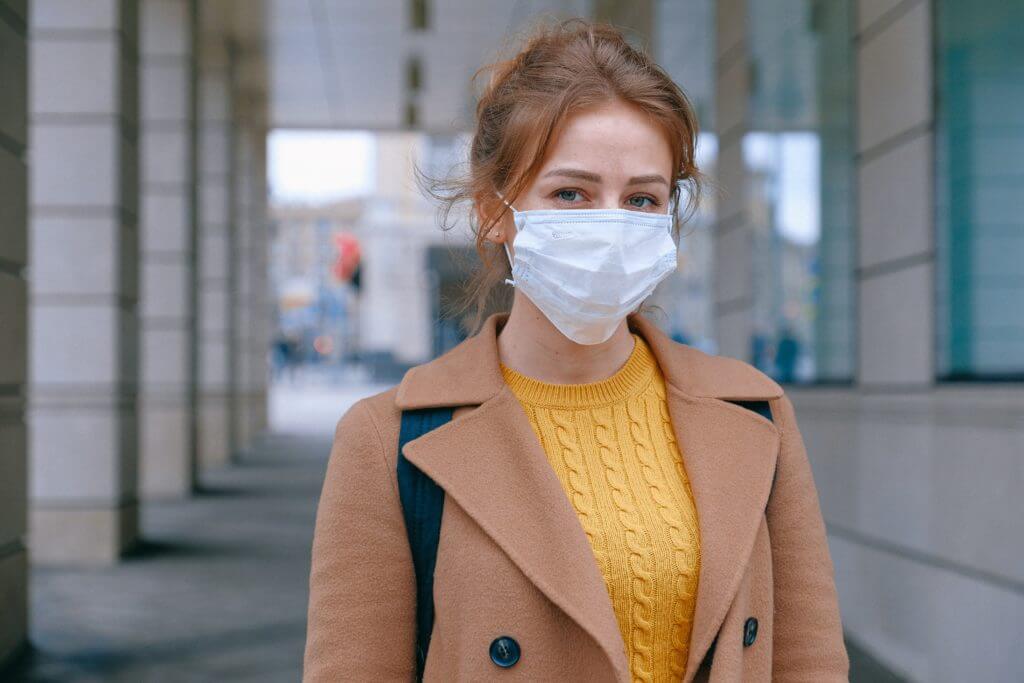After the news broke that 18 residents at a nursing home in Kirkland, Washington have died from Coronavirus, and another 31 residents tested positive, reputable news networks are calling this “nursing homes’ greatest threat in years.”
According to an MSN article, at least 31 residents at Life Care Center nursing home in Kirkland tested positive for Coronavirus and the facility is currently awaiting the results of 20 other residents. Health officials directed the nursing home staff to keep the residents in the nursing home, rather than moving them to hospitals, and to keep the residents who tested negative in a separate wing. Only residents who have acute symptoms are being transferred to hospitals.

Three staff members at the facility have been hospitalized and at least one has tested positive for COVID-19. One person who died from the virus was just a visitor at the nursing home.
On Tuesday the American Health Care Association (AHCA) and the National Center for Assisted Living (NCAL) released new guidelines to protect residents of long-term care facilities from complications of COVID-19.
The top priority at nursing homes, assisted living facilities and other long-term care facilities should be to prevent the virus from entering the facility at all. Preliminary data shows the elderly fatality rate is at 15%. If facilities fail to follow proper protocol or wait until the virus is spreading within the community, it’s probably already too late, according to the guidelines.
Some of the main guidelines include:
- Restricting entry only to individuals who need to enter the facility
- Restricting activities such as visitors, social events, group activities, school groups
- Actively trying to screen anyone who enters the building including employees, contractors, volunteers, government officials, and healthcare professionals
- Requiring everyone who enters the facility to immediately wash their hands. Setting up hand sanitizer stations throughout the facility if possible, and cleaning and disinfecting frequently touched objects or surfaces
- Setting up a process to allow remote communication for residents and their families such as video chat, phone calls, or texting. Also ensuring clear and proactive communication with residents and family

The Centers for Disease Control and Prevention (CDC) recently released “Strategies to Prevent the Spread of COVID-19 in Long-Term Care Facilities.”
According to the CDC, the general strategies to prevent COVID-19 are the same strategies long-term care facilities should already be implementing to prevent and detect infectious diseases. Unfortunately, many long-term care facilities fail to properly manage and implement basic standards of care, which could be detrimental to the health of more than 25,000 nursing home residents in Georgia and more than 12 million Americans nationwide.
The CDC recommends the following strategies to prevent the spread of COVID-19 and other infectious diseases:
- Post signs at the entrance of the facility instructing visitors not to visit if they have symptoms
- Ensure sick leave policies allow employees and staff to stay home if they have symptoms
- Asses resident symptoms of respiratory infection upon admission
- Keep residents and employees informed
- Describe actions being taken to protect them, answer any questions residents (and their families) may have, and explain what they can do to protect themselves and other residents
- Monitor residents and employees for symptoms such as fever, respiratory issues
- Restrict residents from leaving their room who show symptoms. If they must leave their room, have them wear facemasks if possible
- In general, when caring for residents with symptoms, use proper precautions such as face masks, gloves, and eye protection
- Healthcare personnel should monitor local and state public health sources to understand COVID-19
- Ensure employees, residents, and visitors employ good hygiene such as frequently washing their hands, before and after contact with someone or potentially contaminated surfaces
- Put hand sanitizer in every resident’s room
- Make sure tissues are available
- Make sure there is ample soap and paper towels at all sinks
- Identify specific employees to care for COVID-19 patients
- Provide proper infection control training
- Provide all the necessary supplies such as gloves, face masks, gowns, and eye protection
- Ensure there’s a trash can near the exit of each room
- Notify facilities before transferring a resident with confirmed COVID-19
- Report any possible COVID-19 illnesses in residents or employees to the local health department

Because elderly residents are more at-risk and vulnerable to infections and diseases, nursing homes and other long-term care facilities are responsible for preventing, identifying, and containing the spread of infectious diseases. Federal regulations require such facilities to protect their residents and therefore they should already have an infection prevention and control program in place.
If nursing home residents have chronic infections, infections are widespread amongst residents, or unusual or deadly infections are present, it may be a sign of negligence. While infections in nursing homes are common, it is the facility’s responsibility to manage the spread of infections promptly and efficiently.

Federal Regulations require nursing homes to do the following to help prevent the spread of infectious diseases:
§ 483.80 – Infection control.
The facility must establish and maintain an infection prevention and control program designed to provide a safe, sanitary, and comfortable environment and to help prevent the development and transmission of communicable diseases and infections.
(a) Infection prevention and control program. The facility must establish an infection prevention and control program (IPCP) that must include, at a minimum, the following elements:
(1) A system for preventing, identifying, reporting, investigating, and controlling infections and communicable diseases for all residents, staff, volunteers, visitors, and other individuals providing services under a contractual arrangement based upon the facility assessment conducted according to § 483.70(e) and following accepted national standards;
(2) Written standards, policies, and procedures for the program, which must include, but are not limited to:
(i) A system of surveillance designed to identify possible communicable diseases or infections before they can spread to other persons in the facility;
(ii) When and to whom possible incidents of communicable disease or infections should be reported;
(iii) Standard and transmission-based precautions to be followed to prevent spread of infections;
(iv) When and how isolation should be used for a resident; including but not limited to:
(A) The type and duration of the isolation, depending upon the infectious agent or organism involved, and
(B) A requirement that the isolation should be the least restrictive possible for the resident under the circumstances.
(v) The circumstances under which the facility must prohibit employees with a communicable disease or infected skin lesions from direct contact with residents or their food, if direct contact will transmit the disease; and
(vi) The hand hygiene procedures to be followed by staff involved in direct resident contact.
(3) An antibiotic stewardship program that includes antibiotic use protocols and a system to monitor antibiotic use.
(4) A system for recording incidents identified under the facility’s IPCP and the corrective actions taken by the facility.
(b) Infection preventionist. The facility must designate one or more individual(s) as the infection preventionist(s) (IPs) who are responsible for the facility’s IPCP. The IP must:
(1) Have primary professional training in nursing, medical technology, microbiology, epidemiology, or other related field;
(2) Be qualified by education, training,
experience or certification;
(3) Work at least part-time at the facility; and
(4) Have completed specialized training in infection prevention and control.
[81 FR 68868, Oct. 4, 2016]
Read the full list of requirements here.
Our nursing home abuse attorneys have seen first-hand the devastating consequences of facilities that choose profits over patient safety. They’ve worked cases where long-term care facility residents have been critically injured or died as a result of negligence. They’ve helped families who have tragically lost a loved one because a nursing home failed to implement or maintain an infection prevention and control program.
If you or a loved one is in a nursing home and have concerns regarding the implementation of any of the above guidelines, you should contact Healthcare Facility Regulation, a division of the Georgia Department of Community Health at 1-800-878-6442. You can also call The Georgia Department of Public Health at (404) 657-2700.

